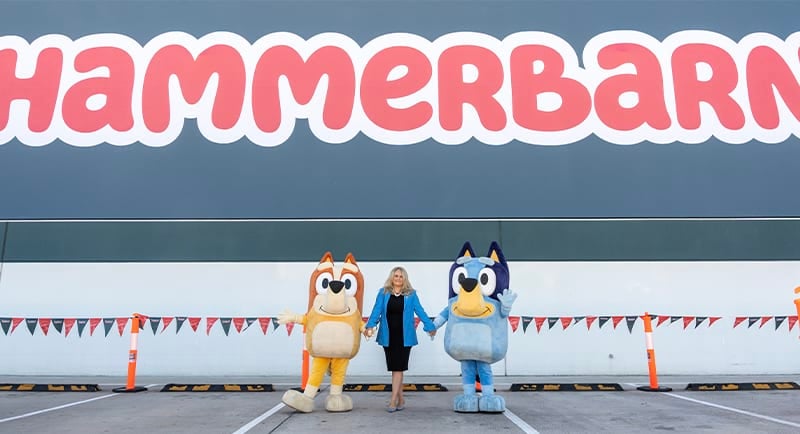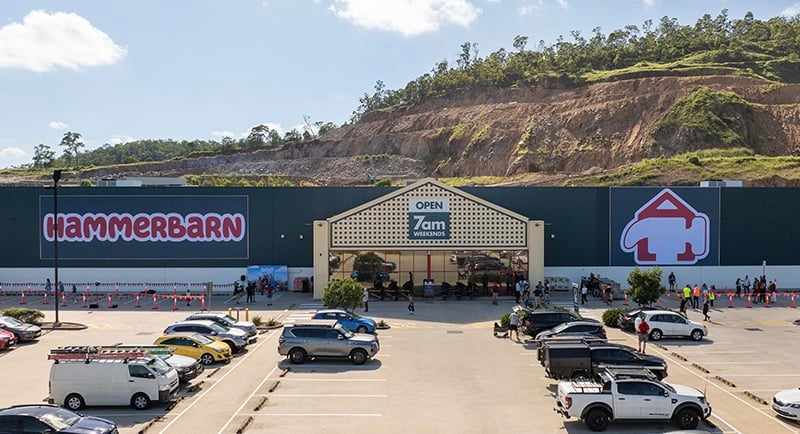Having recently been crowned Australia’s strongest brand, there should be nothing that could make Bunnings change the iconic logo on the side of its warehouses. Nothing, except the power of blue cartoon dog Bluey.
This month, six Bunnings stores in Australia and one in New Zealand are trading in the Bunnings name for Hammerbarn, inspired by a season two episode of the smash hit Ludo Studio cartoon. The campaign comes with a series of Bluey-themed kids DIY workshops held in-store, and exclusive Bluey products including gnomes Hecuba, Jeremy, and Tony.
With the amount of activities and merch that the campaign offers, everyone can be happy with what they have – and nobody’s husband has to eventually get it.
Reflecting on how the campaign came about to begin with, BBC Studios director of brands and licensing ANZ, Kate O’Connor, tells Mediaweek that “The story was actually very simple.”

Kate O’Connor at Hammerbarn
“I reached out to Bunnings’ managing director Mike Schneider, and explained a little bit about the brand, the episode, and the reach of the episode. I wasn’t really sure how much he would know about Bluey, but he got back to me pretty much straightaway and was really enthusiastic about a collaboration together. He mentioned that his wife had bought him the Hammerbarn book for Christmas!
“Once Mike was on board, it started filtering down through both of the organisations at once, and we all started brainstorming – we got to the point where the scale really exceeded our wildest expectations. Bunnings has never done anything like this before, but despite that, they really matched us in terms of innovation and drive.”
The appeal of Bluey doesn’t just end with kids, with adults across the globe – both with kids and without – finding themselves following the adventures of a cartoon dog.
“Bluey is one of the most-watched television shows in the world at the moment, which is just amazing,” said O’Connor. “We don’t take that for granted. It’s in more than 60 countries, 30 languages, it was the second most streamed show in the US last year, and definitely the most streamed show in Australia.
“Being able to do something like this with Bunnings – which is ultimately a store for adults – goes to show the versatility and appeal of Bluey across various demographics.”

When it came to actually bringing the two Aussie icons together, O’Connor points to the values of the show as the core that the project was built around.
“We’ve done some large-scale projects – our collab with Airbnb back in 2022 is a good example of this sort of scale. We do like to do things that are a bit different, a bit outside the norm of the licencing mould.
“We follow the same key strategic pillars when we’re looking at brand collaborations, and at the heart of it is authenticity to the show. We’re a creator-led show, which means we’re not looking at it from a commercial lens first and foremost, although that’s crucial to success. A strong, unified, authentic brand image is what we know will be the key to the longevity and success of our campaigns.”
It takes a brave marketing team to remove the name of a brand during a campaign, but that’s exactly what has happened as Bunnings becomes Hammerbarn. It’s a bold move, and one that O’Connor said reflects the strength of both the brands involved.
“Both brands are so iconic. The campaign doesn’t say Bluey or Bunnings anywhere, but because there’s this knowledge and love of these two icons, just having the word Hammerbarn means something to audiences and consumers of both.”
It’s a sentiment backed up by Victoria Berry, head of strategy at FutureBrand Australia. Berry said the campaign is a great example of Bunning’s bravery in taking risks and tapping into the zeitgeist.
“Bluey is as iconic to kids, families and Australians as Bunnings is but it’s the emotional connection Blue has forged that Bunnings really stands to leverage and build. You know a brand is iconic when it can play around with arguably its most distinctive assets like its logo or name. From the shape of the building to the car park configuration to the sausage sizzle to the range and service style, Bunnings is a fully immersive branded experience, so it has earned the license to be playful.”

For Bunnings, the introduction of the Hammerbarn stores will undoubtedly lead to an increase in families adding a trip to the store to their weekend to-do list. For the BBC, O’Connor said the goals of the campaign came down to bringing Bluey to more Aussies than ever before.
“One of the key objectives is to really weave Bluey deeper into the cultural fabric and keep Bluey front and centre in the zeitgeist, to really maintain that momentum.
“We know that Hammerbarn is a fan-favourite episode, and we also know that many Aussie families have referred to Bunnings as Hammerbarn since the episode aired in season two. So we knew that this was something that could make a huge impact.”
The word “zeitgeist” is also brought up by Berry, who said the campaign is “A great example” of Bunnings successfully tapping into it.
“Bluey is as iconic to kids, families and Australians as Bunnings is, but it’s the emotional connection Bluey has forged that Bunnings really stands to leverage and build.
“Overall, Bunnings do a great job of using purpose as a lens to enhance the in-store experience while continuing to think about new ways to make visits to the store fun. This is pure fun,” Berry concluded.
Teasing that there are “a few more examples of this kind of thing that will emerge in 2024 and 2025,” O’Connor and the team at BBC won’t be slowing down any time soon.
“There’s something incredibly invigorating about working for a company that is in such a strong phase of growth, and one that recognises Australia as being a hub of that growth. I think it allows us a level of risk-taking and gives us an entrepreneurial spirit within the team – it fosters being able to think of these big ideas and take them through to execution.”
